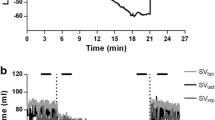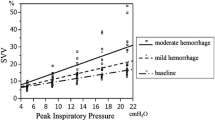Abstract
Cardiac performance is quantitatively and continuously assessed from pressure-volume signals by using the conductance catheter technique even in small animals. Conductivity of blood, however, is dependent on hematocrit (Hct). Interdependence between hematocrit and volume measurement by the conductance catheter has been evaluated. In 12 male Wistar rats weighing 400–475 g, anesthetized and artificially ventilated, Hct was gradually lowered by isovolumic hemodilution ranging from 50% to 7%. Heparinized blood samples were drawn at decreasing Hct levels for centrifugation, for automated Hct measurement by a blood gas analyzer, and for conductance catheter volume measurements (CCV) in calibrated cuvettes. Substitution of about 2 ml colloid solution lowered the Hct initially from 47 ± 2% to 36 ± 3%; at the same time, CCV output rose by 36 ± 14% for definite blood volume. There is a strong inverse linear relationship (|r| > 0.96; P < 0.0001) between relative volume units (RVU) displayed by the volume acquisition device and the hematocrit for any calibrated blood cuvette. Slopes of the regression lines increase proportionally to the calibration volumes (28.3 μl: −0.25; 63.6 μl: −0.57; 113.1 μl: −0.92). These data document the direct interdependence between Hct and CCV. Consequently, careful Hct correction of the RVU recordings is necessary especially in small animals where even small amounts of substituted solutions result in a marked decrease in Hct and, thus, in pronounced blood volume misreadings.



Similar content being viewed by others
References
Baan J, Aouw Jong TT, Kerkhof PLM, Moene RJ, van Dijk AD, van der Velde ET, Koops J. Continuous stroke volume and cardiac output from intra-ventricular dimensions obtained with impedance catheter. Cardiovasc Res 1981;15:328–34
Baan J, van der Velde ET, de Bruin HG, Smeenk GJ, Koops J, van Dijk AD, Temmerman D, Senden J, Buis B. Continuous measurement of left ventricular volume in animals and humans by conductance catheter. Circulation 1984;70:812–23
Barth E, Müller-Plathe O, Haeckel R, Römer M, Keller HE. Multicentre evaluation of the blood gas-electrolyte-analyser “BGE”. Eur J Clin Chem Clin Biochem 1991;29:281–92
Beving H, Eriksson LEG, Davey CL, Kell DB. Dielectric properties of human blood and erythrocytes at radio frequencies (0.2–10 MHz); dependence on cell volume fraction and medium composition. Eur Biophys J 1994;23:207–15
Cassidy SC, Teitel DF. The conductance volume catheter technique for measurement of left ventricular volume in young piglets. Pediatr Res 1992;31:85–90
Fricke H. The electric capacity of suspensions with special reference to blood. J Gen Physiol 1926;9:137–52
Geddes LA, Baker LE. The specific resistance of biological material–a compendium of data for the biomedical engineer and physiologist. Med Biol Eng 1967;5:271–93
Georgakopoulos D, Mitzner WA, Chen C-H, Byrne BJ, Millar HD, Hare JM, Kass DA. In vivo murine left ventricular pressure–volume relations by miniaturized conductance micromanometry. Am J Physiol 1998;274:H1416–22
Günzinger R, Gurdan M, Heimisch W, Schad H, Mendler N, Grammer J, Bauernschmitt R, Lange R, Wildhirt SM. A novel rat model of cardiopulmonary bypass with blood cardioplegic arrest, no need for donor blood and precise hemodynamic assessment by conductance catheter technique. Thorac Cardiov Surg 2006;54(suppl 1):S111
Hopfer SM, Nadeau FL, Sundra M, Makowski GS. Effect of protein on hemoglobin and hematocrit assays with a conductivity-based point-of-care testing device: Comparison with optical methods. Ann Clin Lab Sci 2004;34:75–82
Ito H, Takaki M, Yamaguchi H, Tachibana H, Suga H. Left ventricular volumetric conductance catheter for rats. Am J Physiol 1996;270:H1509–14
Jaspard F, Nadi M. Dielectric properties of blood: an investigation of temperature dependence. Physiol Meas 2002;23:547–54
Mohapatra SN, Hill DW. The changes in blood resistivity with haematocrit and temperature. Eur J Intensive Care Med 1975;1:153–62
Nyboer J, Bagno S, Barnett A, Halsey RH. Radiocardiograms–the electrical impedance changes of the heart in relation to electrocardiograms and heart sounds. J Clin Invest 1940;19:773
Sigman E, Kolin A, Katz LN, Jochim K. Effect of motion on the electrical conductivity of the blood. Am J Physiol 1937;118:708–19
Stewart GN. The conductivity of erythrocytes compared with that of serum. Am J Physiol 1929;90:194–209
Stewart GN. The relative volume or weight of corpuscles and plasma in blood. J Physiol 1899;24:356–73
Stott RAW, Hortin GL, Wilhite TR, Miller SB, Smith CH, Landt M. Analytical artifacts in hematocrit measurements by whole-blood chemistry analyzers. Clin Chem 1995;41:306–11
Uemura K, Sugimachi M, Shishido T, Kawada T, Inagaki M, Zheng C, Sato T, Sunagawa K. Convenient automated conductance volumetric system. Jpn J Physiol 2002;52:497–503
Author information
Authors and Affiliations
Corresponding author
Additional information
The study has been performed and the authors have been named according to the Code of Good Research Practice of the University of Edinburgh (Final Version November 2002).
Rights and permissions
About this article
Cite this article
Heimisch, W., Schad, H. & Günzinger, R. Left Ventricular Volume Measurement by the Conductance Catheter and Variations in the Hematocrit in Small Animals. Cardiovasc Eng 7, 43–46 (2007). https://doi.org/10.1007/s10558-007-9027-7
Published:
Issue Date:
DOI: https://doi.org/10.1007/s10558-007-9027-7




